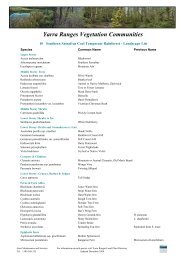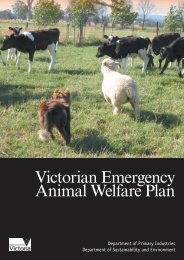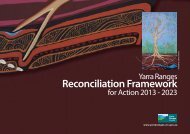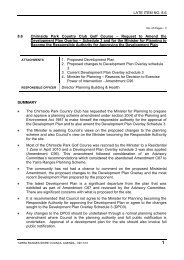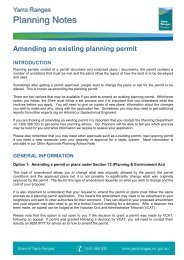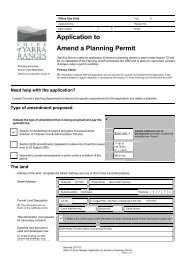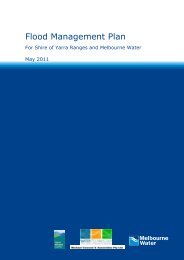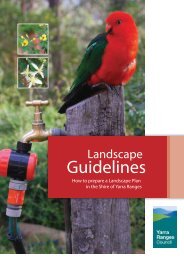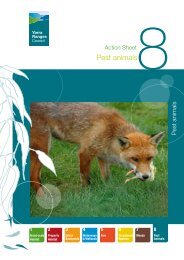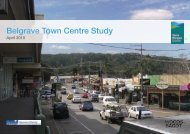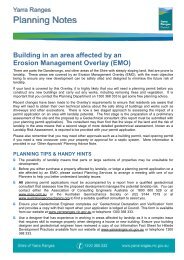Reconciliation - Shire of Yarra Ranges
Reconciliation - Shire of Yarra Ranges
Reconciliation - Shire of Yarra Ranges
- No tags were found...
Create successful ePaper yourself
Turn your PDF publications into a flip-book with our unique Google optimized e-Paper software.
“The <strong>Shire</strong> <strong>of</strong> <strong>Yarra</strong> <strong>Ranges</strong> will be a vibrant and dynamic <strong>Shire</strong> basedon strong local communities living in a place <strong>of</strong> great natural beauty.Our world class <strong>Shire</strong> will be sustained by a strong local economy and a richsocial fabric that is consistent with and supports its environmental values .”<strong>Shire</strong> <strong>of</strong> <strong>Yarra</strong> <strong>Ranges</strong> Vision 2020 - Community PlanMarch 2008Cover Artwork by Ramon Gadd and fellow Oonah Pathway Students from Healesville.Design: Nuttshell Graphics
ContentsI Acknowledgement <strong>of</strong> Country 2II <strong>Reconciliation</strong> and Vision 2020 4III Foreword from the Mayor 51. Indigenous people in the <strong>Shire</strong> <strong>of</strong> <strong>Yarra</strong> <strong>Ranges</strong> 61.1 Indigenous Cultural Heritage 61.2 The Indigenous Population Today 81.3 Contemporary Indigenous Disadvantage 102. <strong>Reconciliation</strong> 122.1 What is reconciliation? 122.3 Why we need a reconciliation strategy 123. Process used to develop the Strategy and Action Plan 133.1 Priorities for Local Indigenous Communities 134. What has been achieved so far? 144.1 Statement <strong>of</strong> Apology 144.2 Statement <strong>of</strong> Commitment to Indigenous Australiansby the <strong>Shire</strong> <strong>of</strong> <strong>Yarra</strong> <strong>Ranges</strong> 154.3 The Indigenous Advisory Committee 164.4 Appointment <strong>of</strong> an Indigenous Development Officer (IDO) 174.5 Meeting Place Garden 185. <strong>Reconciliation</strong> Strategy and Action Plan 195.1 What informed the <strong>Shire</strong>’s <strong>Reconciliation</strong> Strategyand Action Plan? 195.2 The <strong>Shire</strong> <strong>of</strong> <strong>Yarra</strong> <strong>Ranges</strong>’ <strong>Reconciliation</strong> Strategyand Action Plan 196. Priorities identified in the <strong>Reconciliation</strong> Strategy andAction Plan 2008 - 2010 20PRIORITY 1 Maintain an Indigenous voice on Indigenous issues 22PRIORITY 2Acknowledge and protect lndigenouscultural heritage 24PRIORITY 3 Engage Indigenous young people 27PRIORITY 4 Promote Health and Well being 28PRIORITY 5Build stronger relationships and new partnershipswith the wider community in order to promotebusiness and employment opportunities 30Appendix 1: Acknowledgements 32Appendix 2:Local, State and CommonwealthGovernment Policies 332.1 Aboriginal Heritage Act 2006 332.2 <strong>Shire</strong> <strong>of</strong> <strong>Yarra</strong> <strong>Ranges</strong> MunicipalStrategic Statement 332.3 The Victorian Charter <strong>of</strong> Human Rightsand Responsibilities 362.4 The Cultural Respect Framework for Aboriginaland Torres Strait Islander Health Services2004-2009 362.5 Growing Victoria Together 2001-2010 372.6 Department <strong>of</strong> Human Services EasternMetropolitan Region Aboriginal ServicesPlan 2006 – 2009 38Appendix 3: References and useful web links 391
<strong>Reconciliation</strong> and Vision 2020The <strong>Shire</strong> <strong>of</strong> <strong>Yarra</strong> <strong>Ranges</strong>’community plan, Vision 2020,is an optimistic statement byour community <strong>of</strong> whatwe hope for and aspire to forthe future, for both peopleand places.In looking forward into the future, we alsolook back into the past to understand andrespect the history, culture and heritage thatinforms both who we are and where we havecome from.We recognise the unique diversity <strong>of</strong> ourIndigenous Australian community.We are proud to acknowledge the Wurundjeripeople, the original custodians <strong>of</strong> this landand their rich cultural heritage and spiritualconnection to land.We also recognise the significant contribution<strong>of</strong> all other past communities and peoples<strong>of</strong> this region whose lives, interests,decisions and innovation have shapedour diverse communities.We are committed to the ongoing process<strong>of</strong> <strong>Reconciliation</strong> and the strengthening <strong>of</strong>relationships between our Indigenous andnon-Indigenous communities.Listening to the stories about people andplaces in <strong>Yarra</strong> <strong>Ranges</strong> gives an insight toour history - an important part <strong>of</strong> our future.Council has developed a SustainabilityFramework through which it aims to achievethe <strong>Shire</strong> <strong>of</strong> <strong>Yarra</strong> <strong>Ranges</strong>’ community plan,Vision 2020. The Sustainability Frameworkis comprised <strong>of</strong> four Sustainability Principleswhich underpin all Council decisions andactions, including this <strong>Reconciliation</strong> Strategyand Action Plan:• Long term rather than short-term actions;• Strengthening communities;• Developing local solutions in responseto wider issues; and• Working together.4
Foreword from the MayorI am pleased to present the <strong>Shire</strong> <strong>of</strong> <strong>Yarra</strong> <strong>Ranges</strong>’ <strong>Reconciliation</strong>Strategy and Action Plan 2008 – 2010. This three year plan outlinesCouncil’s commitment to working in partnership with Indigenousresidents to further advance the process <strong>of</strong> reconciliation. ThisStrategy will allow Council, the <strong>Shire</strong> as an organisation and otherorganisations and groups to agree on a set <strong>of</strong> common outcomesand actions.Council is proud to acknowledge the traditional custodians <strong>of</strong> theland <strong>of</strong> the <strong>Yarra</strong> <strong>Ranges</strong> <strong>Shire</strong> and to recognise the unique diversity<strong>of</strong> the Indigenous community. The <strong>Shire</strong> <strong>of</strong> <strong>Yarra</strong> <strong>Ranges</strong> has a richIndigenous history, with the area being home <strong>of</strong> the Wurundjeripeople who still retain strong links to their traditional lands withinthe <strong>Shire</strong>.Council has previously adopted a Statement <strong>of</strong> Apology and aStatement <strong>of</strong> Commitment to Indigenous Australians, which givea broad commitment to advance Indigenous cultural awareness andheritage and to advocate on behalf <strong>of</strong> the Indigenous communitiesto ensure that the principles <strong>of</strong> these Statements are upheld. Thesewill continue to be significant Statements. This strategy provides acomprehensive and succinct framework that will guide our futurework. It commits us to a practical plan <strong>of</strong> action to be taken inpartnership with the Indigenous community.I would like to take this opportunity to thank members <strong>of</strong> thecommunity, members <strong>of</strong> the Indigenous Advisory Committee and<strong>Shire</strong> staff for their commitment and dedicated contribution to thedevelopment <strong>of</strong> this <strong>Reconciliation</strong> Strategy.Cr Tim Heenan,Mayor5
1. Indigenous people in the <strong>Shire</strong> <strong>of</strong> <strong>Yarra</strong> <strong>Ranges</strong>1.1 Indigenous Cultural HeritageIndigenous people have lived in Victoria for atleast 40,000 years. Prior to colonisation therewere approximately 36 Indigenous languagesspoken throughout Victoria. Since colonisationmany <strong>of</strong> those languages, particularly inVictoria and other south-eastern states,have been lost. People <strong>of</strong> the Woiwurrunglanguage group, the Wurundjeri people, firstoccupied the areas we call the <strong>Shire</strong> <strong>of</strong> <strong>Yarra</strong><strong>Ranges</strong> today.The Woiwurrung (Wurundjeri) are part <strong>of</strong>what is known as the Kulin Nation. The KulinNation is made up <strong>of</strong> five communities.• Wurundjeri - <strong>of</strong> the <strong>Yarra</strong> catchment• Boonwurrung - <strong>of</strong> the bays andsouth coast• Taungurung - <strong>of</strong> the Goulburn River region• Wathaurong - <strong>of</strong> the western plains• Dja Dja Wurrung - <strong>of</strong> the northwestLoddon RiverThe totem for these groups is Bundjilthe eagle or Waa the raven (crow). TheWurundjeri boundaries lie within the innercity <strong>of</strong> Melbourne and extend north tothe Great Dividing <strong>Ranges</strong>, east to Mt BawBaw, south to Mordialloc and west to theWerribee River.The <strong>Shire</strong> has been home to manyIndigenous leaders, women and men,including William Barak, who becameNgurangaeta, or head person <strong>of</strong> hispeople – the Wurundjeri, and othersliving on Coranderrk.There are a number <strong>of</strong> Wurundjeri culturalheritage sites within the <strong>Shire</strong>. One suchplace <strong>of</strong> significance is Coranderrk MissionStation, which housed many Indigenouspeople who were moved to Healesvillefrom their traditional lands, under protectionand assimilation policies.The <strong>Yarra</strong> River was a central resource forIndigenous communities in the area, andthere are still many ‘scar trees’ to be seenalong the river and inland, left behind byskilful canoe makers. The <strong>Yarra</strong> was a greatsource <strong>of</strong> food as well as a way to travelto the various communities to trade andhold meetings.CoranderrkIn 1858 and 1859 a Parliamentary SelectCommittee <strong>of</strong> Inquiry recommended thatland be set aside for the Aboriginal people.In 1862 a 2800 acre site was chosen in the<strong>Yarra</strong> Valley and became known as the WattsRiver Reserve. This area includes the mainstreet <strong>of</strong> Healesville today.In 1863 Watts River Reserve was closedand the Aboriginal Protection Board approvedthe establishment <strong>of</strong> what became knownas Coranderrk Aboriginal Reserve, a 2300acre parcel <strong>of</strong> land south <strong>of</strong> the township<strong>of</strong> Healesville. Later that year, John Green(Manager <strong>of</strong> Coranderrk from 1862-1873),Simon Wonga and William Barak walkedahead <strong>of</strong> a long line <strong>of</strong> Kulin people on a trekfrom the Acheron to Coranderrk throughwhat became known as “The Blacks Spur”.By 1865 the population <strong>of</strong> Coranderrknumbered 105, making it Victoria’s largestreserve at the time. The Indigenous residentscleared much <strong>of</strong> the property over the nextfour years, developing a thriving farmingcommunity. Coranderrk residents had alsoestablished a bakery, butcher, numeroushouses and a schoolhouse.6
In 1866 Coranderrk was allocated another2500 acres making it a total <strong>of</strong> 4800 acres.The residents cleared the land for farmingand in 1872 planted hops. Coranderrkbecame famous for its hops and wonfirst prize at Melbourne Exhibitions.Coranderrk became self sufficient growing allits own fruit, vegetables and cereals to meetthe needs <strong>of</strong> the Reserve. By 1874 there wasa local push to close the Mission and manyAboriginal people from the mission walkedthe 40 miles to Melbourne to protest toParliament. It was eventually closed in 1924and the residents moved to Lake Tyers.Over time Coranderrk was graduallytaken away and portions sold and usedfor farms, the Army School <strong>of</strong> Health andthe Healesville Sanctuary until all thatremained was the ½ acre cemetery. TheCoranderrk community fought for theirland and were able to secure control <strong>of</strong>Coranderrk’s cemetery and used IndigenousLand Corporation funds to purchasesome <strong>of</strong> the land, including the manager’shouse. (Reference: http://www.abc.net.au/missionvoices/coranderrk/mission_history/default.htmOver the years there have been someareas <strong>of</strong> land returned or leased to thelocal Indigenous people, including:• The Worawa Aboriginal College site;• The original Coranderrk Homesteadsite (controlled by Wandoon EstateAboriginal Corporation);• The Bundjel Gallery site and theToor-Rong site (Galeena BeekProperties Ltd); and• The Former Army School <strong>of</strong> Health site(Wurundjeri Tribe Land Compensation& Cultural Heritage Council Inc.)From these beginnings the local Indigenouscommunity has established a number <strong>of</strong>services specifically for the Indigenouscommunity in the <strong>Shire</strong>. These include:• Coranderrk Aboriginal HousingCooperative Ltd;• Indigenous Health Team (<strong>Yarra</strong> ValleyCommunity Health Services);• Ngwala Willumbong Co-operative Ltd;• Oonah Learning Centre (SwinburneTAFE);• Toor-Rong Aboriginal Corporation Inc;• Wandoon Estate Aboriginal Corporation;• Balluk Yilam Learning Centre (SwinburneTAFE); and the• Healesville Elders’ Association.7
1.2 The IndigenousPopulation TodayVictoria is inhabited by two Indigenouspeoples: Aboriginal People and TorresStrait Islanders. Data from the AustralianBureau <strong>of</strong> Statistics’ (ABS) 2006 Census<strong>of</strong> Population and Housing suggest thatthe Victorian Aboriginal and Torres StraitIslander population is 30,141, representing0.6% <strong>of</strong> the total Victorian population. TheIndigenous population <strong>of</strong> the <strong>Shire</strong> <strong>of</strong> <strong>Yarra</strong><strong>Ranges</strong> is 845, or 0.6% <strong>of</strong> the <strong>Shire</strong>’spopulation. The largest concentration <strong>of</strong>Aboriginal and Torres Strait Islander peoplein the Eastern Metropolitan Region <strong>of</strong>Melbourne is in the <strong>Shire</strong> <strong>of</strong> <strong>Yarra</strong> <strong>Ranges</strong>,accounting for about 35% <strong>of</strong> the Region’stotal Aboriginal and Torres Strait Islanderpopulation.Figure 1.Proportion <strong>of</strong> Aboriginal and Torres Strait Islander People by LocalGovernment Area in the Eastern Metropolitan RegionJuliet Frizzell, Debra Barrow and Maree Ivey. 2005 Victorian Aboriginal andTorres Strait Islander (ATSI) Communities HACC Needs Analysis Phase 2 (2004),Demographic Pr<strong>of</strong>ile, Eastern Metropolitan Region, p. ii.The <strong>Shire</strong>’s Indigenous populationis largely concentrated in and aroundHealesville. One in five (19.1%) <strong>of</strong>the <strong>Shire</strong>’s Indigenous residentslive in Healesville (161 people).The highest concentration <strong>of</strong>Indigenous residents can befound in Badger Creek, where99 residents or 5.5% <strong>of</strong> thetotal population is Indigenous.<strong>Yarra</strong> <strong>Ranges</strong>34.6 %Manningham4.2 %Boroondara8.2 %Whitehorse10.9 %Monash12.9 %Knox15.5 %Maroondah13.6 %8
1.3 Contemporary IndigenousDisadvantageIndigenous people face significantdisadvantages in contemporary Australia,as illustrated by the following data fromthe Australian Bureau <strong>of</strong> Statistics (ABS)and the Australian Institute <strong>of</strong> Health andWelfare (AIHW):Despite significant improvements in theeducational participation and attainment<strong>of</strong> Indigenous Australians in recent years,21.2% <strong>of</strong> Indigenous residents <strong>of</strong> the <strong>Shire</strong>(aged 15 years and over) had completedyear 12 compared with 40.2% <strong>of</strong> the<strong>Shire</strong>’s non-Indigenous population (ABS,Census 2006).Fewer Indigenous households in the <strong>Shire</strong>have access to the Internet. In 2006, 53.4%had Internet access compared with 66.9%<strong>of</strong> non-Indigenous households (ABS,Census 2006).2006 ABS Census data indicate that40.9% <strong>of</strong> Indigenous residents <strong>of</strong> the <strong>Shire</strong>earn less than $250 per week. This is aconsiderably higher proportion than thatfor the overall <strong>Shire</strong> population at 27.5%(ABS, Census 2006).Data about disability captured for the firsttime in the 2006 Census found that 4.7%<strong>of</strong> the <strong>Shire</strong>’s Indigenous residents havea pr<strong>of</strong>ound or severe disability. This isconsiderably higher than the 3.3% forall <strong>Shire</strong> residents (ABS, Census 2006).“The prevalence <strong>of</strong> disability amongIndigenous people is higher at all ages.In 2002, over two-thirds <strong>of</strong> people aged55–64 years, and one-half <strong>of</strong> people aged45–54 years had a disability or long-termhealth condition. The earlier onset <strong>of</strong>disability or long-term health conditionswith a pr<strong>of</strong>ound or severe core activitylimitation indicates the comparatively higherneed for service provision for Indigenouspeople with a disability at younger ages”.(ABS and AIHW The Health and Welfare<strong>of</strong> Australia’s Aboriginal and Torres StraitIslander Peoples 2005)“For the period 2000–02, 78% <strong>of</strong> Indigenousmothers who gave birth were aged under30 years, compared with 49% <strong>of</strong> othermothers. In 2003, the total fertility rate (TFR)for Indigenous women was estimated to be2.15 babies, compared with 1.76 babies forthe total Australian population”. (ABS andAIHW The Health and Welfare <strong>of</strong> Australia’sAboriginal and Torres Strait IslanderPeoples 2005)10
“The prevalence <strong>of</strong> diabetes amongIndigenous Australians was nearlyfour times the prevalence reported bynon-Indigenous Australians; diabetes wasmanaged at a rate <strong>of</strong> 7 per 100 encounterswith Indigenous Australians compared to3 per 100 encounters with all Australiansand Indigenous Australians were hospitalisedfor diabetes at five times the rate <strong>of</strong> otherAustralians”. (ABS and AIHW The Healthand Welfare <strong>of</strong> Australia’s Aboriginal andTorres Strait Islander Peoples 2005)“In the period 1996–2001, the life expectancyat birth for Indigenous Australians wasestimated to be 59.4 years for males and64.8 years for females, compared with76.6 years for all males and 82.0 yearsfor all females for the period 1998–2000,a difference <strong>of</strong> approximately 17 yearsfor both males and females”. (ABS andAIHW The Health and Welfare <strong>of</strong> Australia’sAboriginal and Torres Strait IslanderPeoples 2005)Aboriginal and Torres Strait Islander childrenwere over-represented in the child protectionsystems across most <strong>of</strong> Australia, with ratios<strong>of</strong> 10:1 in Victoria. The rate <strong>of</strong> Indigenouschildren being placed under care andprotection orders and in out-<strong>of</strong>-home carewas higher than the rate for other childrenin all jurisdictions. (ABS and AIHW TheHealth and Welfare <strong>of</strong> Australia’s Aboriginaland Torres Strait Islander Peoples 2005)“Indigenous males and females werehospitalised for care involving dialysis at9 and 17 times the rate <strong>of</strong> other Australianmales and females, and for potentiallypreventable chronic conditions they werehospitalised at seven times the rate <strong>of</strong> otherAustralians. Torres Strait Islander peoplecomprise 11% <strong>of</strong> Australia’s Indigenouspopulation”. (ABS and AIHW The Healthand Welfare <strong>of</strong> Australia’s Aboriginal andTorres Strait Islander Peoples 2005)11
2. <strong>Reconciliation</strong>2.1 What is reconciliation?<strong>Reconciliation</strong> Australia provides a helpfuldefinition <strong>of</strong> reconciliation:Our vision is for an Australia that recognisesthe special place and culture <strong>of</strong> Aboriginaland Torres Strait Islander peoples as the FirstAustralians, values their participation andprovides equal life chances for all.<strong>Reconciliation</strong> involves justice, recognitionand healing. It’s about helping all Australiansmove forward with a better understanding <strong>of</strong>the past and how the past continues to affectthe lives <strong>of</strong> Indigenous people today.<strong>Reconciliation</strong> involves symbolic recognition<strong>of</strong> the honoured place <strong>of</strong> the first Australians,as well as practical measures to address thedisadvantage experienced by Indigenouspeople in health, employment, educationand general opportunity. (http://www.reconciliation.org.au/i-cms.isp)2.2 Why we need a reconciliationstrategyThe <strong>Shire</strong> <strong>of</strong> <strong>Yarra</strong> <strong>Ranges</strong> recognises therange <strong>of</strong> social and economic benefits tothe whole community in working towardsreconciliation with Indigenous Australians.The <strong>Reconciliation</strong> Strategy provides aframework for action. It was designed inconsultation between Indigenous communitymembers and <strong>Shire</strong> <strong>of</strong>ficers. Its principlesand policies are demonstrated throughpractical, well-planned actions.The <strong>Shire</strong> <strong>of</strong> <strong>Yarra</strong> <strong>Ranges</strong> and the IndigenousAdvisory community identified the followingaspirations for a <strong>Reconciliation</strong> Strategy:• a more harmonious community;• a shared understanding and pride inthe <strong>Shire</strong>’s Indigenous cultural heritage;• a greater ability to work together andshare responsibility for a better future;• greater opportunities for employment;• greater opportunities for accessto services;• an improved economy as more peopleparticipate as employees and consumers.This benefits business, industry,communities and individuals;• greater diversity in the workplace whichbetter represents the broader community;• opportunities for joint ventures withIndigenous communities that createnew business and cultural benefitsfor the community;• a sense <strong>of</strong> pride in a local community thatrecognises Indigenous history and worksto address social inequality; and• the opportunity to experience Indigenousculture through regular events andactivities, such as for NAIDOC week(National Aboriginal and Torres StraitIslander Day Observance Committee).12
3. Process used to develop the Strategy and Action PlanThis <strong>Reconciliation</strong> Strategy and Action Planwas developed in close consultation with the<strong>Shire</strong> <strong>of</strong> <strong>Yarra</strong> <strong>Ranges</strong> Indigenous AdvisoryCommittee (IAC), key community leadersand <strong>Shire</strong> staff.Input from the IAC was sought througha six month consultation process withthe assistance <strong>of</strong> project facilitatorsrecommended by Aboriginal and TorresStrait Islander members <strong>of</strong> the Committee.The facilitators worked with the IACin a process that:• identified priority areas for localcommunity across all areas <strong>of</strong> life;• grouped these priority areas intothemes; and• discussed themes and identified whatneeds to be improved, strategies forimprovement and key stakeholdersto be involved in future action.The IAC also invited others when theCommittee wanted further input todiscussions. This included other members<strong>of</strong> the local Aboriginal and Torres StraitIslander community, Traditional Ownersand members <strong>of</strong> Council relevant toparticular themes under discussion.The priority areas were grouped into themesand a member <strong>of</strong> the IAC chaired a WorkingParty for each theme. Committee memberswere asked to join one <strong>of</strong> the groups tocontribute to a more detailed examination<strong>of</strong> the issues and strategies to addressthem. One <strong>of</strong> the regular IAC meetingswas given over to starting <strong>of</strong>f the WorkingParties and each met outside the regularmeeting timetable to progress the work.Each reported back on what they hadworked through and feedback was given andincorporated where appropriate. This workformed the actions identified in this Strategyand Action Plan.3.1 Priorities for local IndigenouscommunitiesDuring a community forum process,Indigenous people living in the <strong>Shire</strong> <strong>of</strong> <strong>Yarra</strong><strong>Ranges</strong> identified a number <strong>of</strong> priorities:• better health;• support to the young, including bymeans <strong>of</strong> education, employment andre-connection with culture and Elders;• acknowledgement and protection<strong>of</strong> Indigenous cultural heritage;• maintaining an Indigenous voiceon Indigenous issues; and• building better relationships andpartnerships with the wider <strong>Shire</strong>community and stakeholders inorder to promote business andother growth opportunities.13
4. What has been achieved so far?4.1 Statement <strong>of</strong> ApologyIn 1997 the <strong>Shire</strong> <strong>of</strong> <strong>Yarra</strong> <strong>Ranges</strong> workedwith local community members to write an<strong>of</strong>ficial apology to the Indigenous Communityfor past injustices. This acknowledgment <strong>of</strong>past injustices is considered by the <strong>Shire</strong> tobe an important part <strong>of</strong> reconciliation withIndigenous communities. It validates theexperiences <strong>of</strong> Indigenous Australians aswell as provides a bridge between culturesthat supports collaborative efforts to addressthose injustices.Statement <strong>of</strong> ApologyThe <strong>Yarra</strong> <strong>Ranges</strong> <strong>Shire</strong> Council recognises the pastinjustices and treatment <strong>of</strong> Aboriginal Peoples.If we are to proceed in an openhearted and responsibleway to address the issues which will come before us inthe future we first need to acknowledge the past.Council recognises the need to confront the policies andpractices which caused the forced removal and separation<strong>of</strong> Aboriginal children from their parents and families, theeffects <strong>of</strong> which continue today.Accordingly, we wish to express our deep sorrow andsincerely apologise for the pain, the grief and the sufferingexperienced by Aboriginal Peoples as a result <strong>of</strong> past laws,government policy and actions.14
4.2 Statement <strong>of</strong> Commitmentto Indigenous Australiansby the <strong>Shire</strong> <strong>of</strong> <strong>Yarra</strong> <strong>Ranges</strong>Council endorsed a Statement <strong>of</strong>Commitment to Indigenous Australiansby the <strong>Shire</strong> <strong>of</strong> <strong>Yarra</strong> <strong>Ranges</strong> in 1997 aspart <strong>of</strong> the National <strong>Reconciliation</strong> Process.The Statement was developed in consultationwith local Indigenous community membersand acknowledges the historical andcultural value <strong>of</strong> Indigenous Australiansand recognises the principles <strong>of</strong> equityand access for Indigenous communitiesto their heritage.Statement <strong>of</strong> Commitment to IndigenousAustralians by the <strong>Shire</strong> <strong>of</strong> <strong>Yarra</strong> <strong>Ranges</strong>The <strong>Shire</strong> <strong>of</strong> <strong>Yarra</strong> <strong>Ranges</strong> recognise:• the habitation <strong>of</strong> this land by localIndigenous people;• the customs and traditions <strong>of</strong> IndigenousAustralians and their spiritual relationshipwith the land;• the valuable contribution made byIndigenous people and their cultureto the history <strong>of</strong> the region;• the value <strong>of</strong> the diversity and strength<strong>of</strong> Indigenous cultures to the heritage<strong>of</strong> all Australians; and• the principles <strong>of</strong> equity and access for allmembers <strong>of</strong> the Indigenous communityto culturally appropriate servicesand programs.The Council supports:• the rights <strong>of</strong> all Indigenous people asoutlined in the Draft United NationsDeclaration on The Rights <strong>of</strong> IndigenousPeople; and• the vision as expressed by the Councilfor Aboriginal <strong>Reconciliation</strong> <strong>of</strong> a “unitedAustralia which respects this land <strong>of</strong> ours,values the Aboriginal and Torres StraitIslander heritage and provides justiceand equality for us all.”The Council is committed to:• promoting and facilitating the preservation<strong>of</strong> Indigenous cultural heritage in away that is sensitive to and respectsthe dignity and protocols <strong>of</strong> the localIndigenous community;• participating in education processeswhich enhance the understanding andawareness <strong>of</strong> Indigenous heritage and theneeds <strong>of</strong> our Indigenous communities;• undertaking and participating in programsand activities which display our ongoingcommitment to Indigenous issues; and• advocating on behalf <strong>of</strong> the Indigenousmembers <strong>of</strong> our community to ensurethe principles and commitments <strong>of</strong> thisstatement are upheld.15
4.3 The IndigenousAdvisory CommitteeThe <strong>Shire</strong> <strong>of</strong> <strong>Yarra</strong> <strong>Ranges</strong> IndigenousAdvisory Committee (IAC) was establishedto advise Council on issues that impact onIndigenous individuals, organisations orpolicy, and to provide a platform for ongoingconsultation between the Indigenouscommunity and the <strong>Shire</strong> <strong>of</strong> <strong>Yarra</strong> <strong>Ranges</strong>.The IAC seeks to provide opportunities forself-determination and improve access toculturally appropriate services by raisingawareness <strong>of</strong> Indigenous issues, historyand culture.The IAC developed and will oversee the<strong>Shire</strong>’s <strong>Reconciliation</strong> Strategy and ActionPlan to implement Council’s Statement <strong>of</strong>Commitment to Indigenous Australians:“Council will, in consultation withthe Indigenous community, preparea plan that reflects the needs <strong>of</strong> thecommunity and meets the Vision 2020expectation that each community isstrong, and the individuals in each arerespected. Age and racial differencesare valued, and people live in respectfulharmony with their environment andtheir Indigenous heritage.”The IAC is comprised <strong>of</strong> local Indigenouscommunity members, relevant communityrepresentatives, Councillors and <strong>Shire</strong>staff. It regularly invites others to itsmeetings to provide specific expertiseand guidance where appropriate. A keyfunction <strong>of</strong> the IAC is the development<strong>of</strong> a <strong>Reconciliation</strong> Strategy.IAC Terms <strong>of</strong> Reference outline thefollowing:• support initiatives to reduce Indigenousdisadvantage;• improve social justice opportunitiesfor the <strong>Shire</strong> <strong>of</strong> <strong>Yarra</strong> <strong>Ranges</strong> Indigenouscommunity;• plan events that acknowledge thesignificant occasions for the Indigenouscommunity paying particular attentionto Sorry Day and NAIDOC week byfostering reconciliation;• act as a catalyst for reconciliation issuesbetween the Indigenous community,the <strong>Shire</strong> <strong>of</strong> <strong>Yarra</strong> <strong>Ranges</strong> and thewider community;• make recommendations to Council ona broad range <strong>of</strong> community issues thatmay affect the Indigenous community<strong>of</strong> the <strong>Shire</strong> <strong>of</strong> <strong>Yarra</strong> <strong>Ranges</strong>;• guide the development <strong>of</strong> Council’saction plan to address issues concerningthe Indigenous community and Council’songoing role;• support the development <strong>of</strong> appropriateCouncil policies in response to theStatement <strong>of</strong> Commitment to IndigenousAustralians;• increase cross cultural awareness withinthe <strong>Shire</strong> <strong>of</strong> <strong>Yarra</strong> <strong>Ranges</strong> across all levels;• support the Indigenous DevelopmentOfficer in the achievement <strong>of</strong> theposition’s role and function;• assist the Indigenous communityin its pursuits <strong>of</strong> self determination,economic development and communitysustainability; and• work in partnership with SwinburneUniversity to strengthen outcomesfor the Indigenous community.16
4.4 Appointment <strong>of</strong> an IndigenousDevelopment OfficerCouncil endorsed a full time IndigenousDevelopment Officer (IDO) in 2006, toprovide a single focus on the developmentand implementation <strong>of</strong> policies and programsthat directly benefit Indigenous residents<strong>of</strong> the <strong>Shire</strong>. The role includes working tothe IAC and being a conduit between it and<strong>Shire</strong> councillors and staff. The position waspreviously a part-time position.The Indigenous Development Officer worksas part <strong>of</strong> the Economic and CommunityDevelopment Department, within the Socialand Economic Development Directorateto implement the following key IndigenousDevelopment objectives:• support greater access by Indigenousresidents to a range <strong>of</strong> communityservices and opportunities;• assist Indigenous residents to identify andaddress community needs and concerns;• promote greater recognition andunderstanding <strong>of</strong> the issues affectingIndigenous people and communitieswithin the <strong>Shire</strong> to enhance serviceresponse and planning; and• support the Indigenous AdvisoryCommittee to achieve its statedobjectives as outlined in the Terms<strong>of</strong> Reference with particular emphasison the Strategic Plan.The Indigenous Development Officer(IDO) works with the Indigenous AdvisoryCommittee and Council to develop policyand programs including the <strong>Reconciliation</strong>Strategy and Action Plan that enhancea greater understanding and connectionbetween the Indigenous community andthe broader communities <strong>of</strong> the <strong>Shire</strong> <strong>of</strong><strong>Yarra</strong> <strong>Ranges</strong>.17
4.5 Meeting Place GardenThe Meeting Place Garden project waslaunched in February 2006, when MaoriNgai Tahu visitors from New Zealand andthe Healesville Aboriginal communitycame together for a series <strong>of</strong> traditionalIndigenous arts and craft workshops after amoving welcome ceremony in Queens ParkHealesville. The project was devised in June2005 after a <strong>Shire</strong> <strong>of</strong> <strong>Yarra</strong> <strong>Ranges</strong> delegation,which included a Wurundjeri Elder, returnedfrom a visit to the Ngai Tahu communityin New Zealand in the lead up to the 2006Melbourne Commonwealth Games. The ideawas to create a formal place for the sharing<strong>of</strong> cultural experiences.The Meeting Place Garden celebrates thecoming together <strong>of</strong> Indigenous and Maoriculture. The project resulted in the creation<strong>of</strong> a new garden featuring Australianand New Zealand indigenous flora andsite-specific art works <strong>of</strong> significant culturalimportance. It has been created througha unique partnership between the localIndigenous community and the Ngai Tahucommunity in New Zealand (the largesttribe <strong>of</strong> Maori people in the South Island).The Meeting Place garden will include acollection <strong>of</strong> traditional food and medicinalplants, chosen by participating Indigenousand Maori groups. The Garden will featurean ecologically sustainable plant design,which will highlight natural plant selectionand habitat niches. It is envisaged that thegarden will also incorporate a botanicaleducation trail.Art works <strong>of</strong> significant cultural importancehave been integrated into the garden design.An Indigenous artist worked with a team<strong>of</strong> local Indigenous artists and artisansto construct a paving installation. Artistsfrom the Ngai Tahu community in NewZealand were invited to visit Healesvilleand create site specific art work tocomplement the Garden.18
6. Priorities identified in the <strong>Reconciliation</strong> Strategyand Action Plan 2008 - 2010Priority 1Maintain an Indigenous voice on Indigenous issuesPriority 2Acknowledge and protect Indigenous cultural heritagePriority 3Engage Indigenous young peoplePriority 4Promote health and well beingPriority 5Build stronger relationships and new partnershipswith the wider community to promote businessand employment opportunities.20
Priority 1 Maintain an Indigenous voice on Indigenous issuesGOALTo ensure that Indigenous residents have the opportunity to activelyparticipate in Council planning and decision making processes.ObjectiveStrategiesWho is to implementPerformance IndicatorsTimeline1.1 To have an effectiveand highly regardedIndigenous AdvisoryCommittee (IAC).1.1.1. Ensure that the <strong>Shire</strong> <strong>of</strong> <strong>Yarra</strong> <strong>Ranges</strong>IAC Terms <strong>of</strong> Reference are current.1.1.2. Convene regular meetings <strong>of</strong> the IACand prepare a calendar <strong>of</strong> key datesfor Indigenous events.IAC, Executive Officer Social Planningand Development and IndigenousDevelopment Officer.IAC Chair and Manager Economic andCommunity Development.Terms <strong>of</strong> Referencereviewed.Bi monthly meetings areconducted in accordance withTerms <strong>of</strong> Reference.OngoingOngoing1.1.3. Provide the IAC up-to-dateadvice and information onCouncil decisions and actionsthat may impact on theIndigenous community.Executive Officer Social Planningand Development and IndigenousDevelopment Officer.IAC has the opportunityto provide timely inputinto all key decisionmaking processes.Ongoing1.2 Advance Council’scommitment to theprocess <strong>of</strong> reconciliation.1.2.1 Facilitate the implementation <strong>of</strong> the<strong>Shire</strong>’s <strong>Reconciliation</strong> Strategy andAction Plan.IAC and Indigenous Development Officer.Plan implemented.201022
ObjectiveStrategiesWho is to implementPerformance IndicatorsTimeline1.2.2 Actively engage in collaborativediscussions with Indigenous groups,and communities by facilitatingIndigenous community forums thatdeal with specific issues and topics.IAC and Indigenous Development Officer.Support for and activeparticipation in tw<strong>of</strong>orums annually.Annually1.2.3 Provide annual progress reportson action taken in relation to allthe priorities in this plan.IAC, Executive Officer Social Planningand Development and IndigenousDevelopment Officer.Annual reports to Council.Annually1.3 To provide a platformfor Indigenous Eldersto express issues<strong>of</strong> concern, needsand priorities <strong>of</strong>Indigenous people.1.3.1 Coordinate forums andone-to-one interviews withElders to identify their concerns,needs and priorities.IAC, Executive Officer Social Planningand Development and IndigenousDevelopment Officer.Issues are documented anddiscussed at IAC meetings.Annually23
PRIORITY 2 Acknowledge and protect lndigenous cultural heritage.GOALTo acknowledge and respect our Indigenous culture and heritage.ObjectiveStrategiesWho is to implementPerformance IndicatorsTimeline2.1 Develop a process tobetter identify and mapsignificant cultural heritagesites within the <strong>Shire</strong>.2.1 Identify funding that will facilitatea process involving Aboriginal AffairsVictoria, Traditional Owners andthe <strong>Shire</strong> <strong>of</strong> <strong>Yarra</strong> <strong>Ranges</strong> StrategicPlanning to identify cultural siteswithin the <strong>Shire</strong> <strong>of</strong> <strong>Yarra</strong> <strong>Ranges</strong>.IAC, <strong>Shire</strong> <strong>of</strong> <strong>Yarra</strong> <strong>Ranges</strong> PlanningDepartment, Traditional Owners,Aboriginal Affairs Victoria, IndigenousDevelopment Officer and IndigenousCommunity Members.Funding sourced andCultural sites identified anddocumented.20092.2 Identify and promotethe requirements <strong>of</strong> theCultural Heritage Actand how it will impacton the community.2.2.1 Provide information and facilitateforums on the Aboriginal Heritage Act2006 to <strong>Shire</strong> staff and Community.2.2.2 Work with Council to develop aprotocol that is consistent withthe Aboriginal Heritage Act 2006around Indigenous cultural heritageidentification and protection.IAC Cultural Heritage Working Groupand Indigenous Development Officer.IAC Cultural Heritage Working Group,Indigenous Development Officer and<strong>Shire</strong> <strong>of</strong> <strong>Yarra</strong> <strong>Ranges</strong> Strategic Planning.Forums conducted.Protocol developed.200920092.4 To identify, developand distribute protocolsfor working with localTraditional Owners,Indigenous organisations,and Indigenouscommunities.2.4.1 Maintain and develop a strongworking relationship with theWurundjeri Tribe Land Compensationand Cultural Heritage CouncilInc. (Wurundjeri Council) andWandoon Estate.IAC, Indigenous Development Officer,Wurundjeri Council and Wandoon Estate.Consultation occurs withWurundjeri Organisationsas required.200824
ObjectiveStrategiesWho is to implementPerformance IndicatorsTimeline2.4.2 Seek advice from the WurundjeriCouncil and Wandoon Estateregarding protocols for:• How the <strong>Shire</strong>, communitygroups and individuals can workin partnership with the TraditionalOwners on Indigenous matters; andIAC, <strong>Shire</strong> <strong>of</strong> <strong>Yarra</strong> <strong>Ranges</strong>, IndigenousDevelopment Officer, Traditional Ownersincluding Wurundjeri Council andWandoon Estate.Protocol developed andendorsed by IAC.2008• Welcome to Country,Acknowledgement <strong>of</strong> Country,flying the flag, and third flag pole.2.4.3 Develop a Memorandum <strong>of</strong>Understanding between IAC, <strong>Shire</strong><strong>of</strong> <strong>Yarra</strong> <strong>Ranges</strong> and other Indigenousorganisations and Community Elders.IAC, <strong>Shire</strong> <strong>of</strong> <strong>Yarra</strong> <strong>Ranges</strong>, andIndigenous organisations.Memorandum <strong>of</strong>Understanding completed andendorsed by IAC for Councilagreement.20092.4.4 Ensure that the significant role playedby Indigenous members <strong>of</strong> the localcommunity other than Wurundjeriis acknowledged in the development<strong>of</strong> protocols.IAC, Traditional Owners, IndigenousDevelopment Officer andCommunity EldersAppropriate acknowledgementincorporated within allprotocols established.Ongoing2.5 To publicly acknowledgeand respect thecontribution <strong>of</strong> Indigenousculture and heritage inthe <strong>Shire</strong>.2.5.1 Acknowledge the Wurundjerias traditional owners <strong>of</strong> the land(at identified Council, civic andcommunity meetings and events).2.5.2 Develop information for thecommunity that explains the meaningand significance <strong>of</strong> flags, Welcometo Country and Acknowledgement<strong>of</strong> Country.IAC, Indigenous Development Officer,Cultural Heritage Working Groupand Councillors.IAC and Indigenous Development Officer.Acknowledgement Statementis made at key Council events.Information provided on the<strong>Shire</strong> website.Ongoing200825
ObjectiveStrategiesWho is to implementPerformance IndicatorsTimeline2.6 Highlight and acknowledgethe unique culture <strong>of</strong>Indigenous people.2.6.1 Cultural Awareness Training (CAT)will be incorporated into the<strong>Shire</strong>’s corporate learning andinduction programs.IAC Cultural Heritage Working Group andIndigenous Development Officer.CAT incorporated within<strong>Shire</strong>’s Corporate Learningand induction programs.20082.6.2 Establish (through the IAC) an eventsub committee that will identifyand facilitate the development <strong>of</strong>an annual stand alone event thatcelebrates Indigenous cultural lifeincluding food, music, dance and art.IAC, Oonah, Wurundjeri Counciland MMIGP.Annual event established andfunding identified.Ongoing2.7 Facilitate specific projectsrelevant to culturaland community life <strong>of</strong>Indigenous residents.2.7.1 Support community initiatives thatrecognise <strong>Reconciliation</strong> Week andNAIDOC Week.IAC Cultural Heritage Working groupand Indigenous Development Officer.Community events conductedduring <strong>Reconciliation</strong>and NAIDOC Week aresupported.Annually2.7.2 Support the following activitiesto determine the feasibility <strong>of</strong>establishing an Indigenous communitycentre:Executive Officer Social Planningand Development and IndigenousDevelopment Officer.The Indigenous CommunityCentre Reference Group issupported in its development<strong>of</strong> the project.Ongoing• identification <strong>of</strong> potential sites;• identification <strong>of</strong> fundingopportunities;• participation in design concepts; and• advocacy for the project withgovernment.26
PRIORITY 3 Engage Indigenous young people.GOALTo increase social inclusion and connection to positive pathways for youngAboriginal and Torres Strait Islander people.ObjectiveStrategiesWho is to implementPerformance IndicatorsTimeline3.1 Support initiatives thatfocus on building socialand emotional wellbeing.3.1.1 Facilitate the engagement <strong>of</strong> youngpeople on the IAC with a particularfocus on health and wellbeing.IAC, Indigenous Development Officer,Indigenous Health Service and the <strong>Shire</strong><strong>of</strong> <strong>Yarra</strong> <strong>Ranges</strong> Youth Services.Young Indigenous and TorresStrait Islander residents havea strong representative voiceon the IAC.20093.1.2 Establish a mentor program inpartnership with Indigenous andnon Indigenous organisationsincluding local Elders.IAC, Young Indigenous and Torres StraitIslander people and IndigenousYouth Strategy Working Party.Mentor program established.20093.1.3 Engage young Indigenous and TorresStrait Islander people in the planningand development <strong>of</strong> <strong>Shire</strong> <strong>of</strong> <strong>Yarra</strong><strong>Ranges</strong> Youth Services programs andactivities through the Indigenous YouthStrategy Working party which includes:IAC, Young Indigenous and Torres StraitIslander people and the Indigenous YouthStrategy Working Party.Indigenous young peopleparticipate in a range <strong>of</strong><strong>Shire</strong> <strong>of</strong> <strong>Yarra</strong> <strong>Ranges</strong> YouthServices programs.Ongoing• Young Leaders Program;• Indigenous Youth Forum; and• Activities during NAIDOC week.27
PRIORITY 4 Promote Health and Well being.GOALTo ensure that Indigenous health priorities are identified and incorporatedwithin <strong>Shire</strong> <strong>of</strong> <strong>Yarra</strong> <strong>Ranges</strong> Planning mechanisms.ObjectiveStrategiesWho is to implementPerformance IndicatorsTimeline4.1 Provide positive actionto progress the healthand well being <strong>of</strong>Indigenous residents.4.1.1 Ensure that the IAC has input intothe development <strong>of</strong> the <strong>Shire</strong>’sCommunity Wellbeing Plan.IAC Health Working Party, ExecutiveOfficer Social Planning and Developmentand Indigenous Development Officer.Key health priorities identifiedhave been incorporatedinto the <strong>Shire</strong>’s CommunityWellbeing Plan.20104.1.2 Develop and provide educationalprojects which raise awareness <strong>of</strong>Indigenous heritage and reconciliation.<strong>Shire</strong> <strong>of</strong> <strong>Yarra</strong> <strong>Ranges</strong> Arts, Culture andHeritage Department and IndigenousDevelopment Officer.Education projects delivered.20104.1.3 Enhance the skills <strong>of</strong> healthpractitioners to improve socialand emotional health and wellbeing outcomes for Indigenouscommunities through cultural training.Outer East Primary Care Partnership,Community Health Centres, Social Policyand Development Officer and IndigenousDevelopment Officer.Cultural training activitiesprovided.20094.1.4 Support the development <strong>of</strong> anindependent Indigenous healthservices through participationon the Transition to Governanceworking party.Manager Economic and CommunityDevelopment and <strong>Yarra</strong> Valley CommunityHealth Services.<strong>Shire</strong> participation onTransitions to GovernanceWorking Group.Ongoing28
ObjectiveStrategiesWho is to implementPerformance IndicatorsTimeline4.2 Provide culturallyappropriate child care andfamily day care services.4.2.1 Build sustainable parenting byidentifying and engaging vulnerablefamilies and providing access toculturally appropriate Maternal andChild Services.Executive Officer Family and Children’sServices,<strong>Yarra</strong> Valley Community HealthServices, Indigenous Health Teamand Anglicare.Families engaged inparenting programs.Ongoing4.2.2 Develop a plan to review theaccessibility <strong>of</strong> Council fundedearly childhood services forIndigenous families.<strong>Shire</strong> <strong>of</strong> <strong>Yarra</strong> <strong>Ranges</strong> Family and ChildrenServices, Indigenous Health Team andIndigenous Development Officer.Review undertaken with inputfrom Indigenous community.Plan developed containingappropriate actions toaddress issues.20084.2.3 Assist service providers to implementand review recommendations.<strong>Shire</strong> <strong>of</strong> <strong>Yarra</strong> <strong>Ranges</strong> Family and ChildrenServices, Indigenous Health Service andIndigenous Development Officer.Services become moreculturally aware.20084.2.4 Investigate options for thedevelopment <strong>of</strong> appropriate serviceprovision for Indigenous children.<strong>Shire</strong> <strong>of</strong> <strong>Yarra</strong> <strong>Ranges</strong> Family and ChildrenServices, Indigenous Health Service andIndigenous Development Officer.Report prepared identifyingappropriate options forconsideration.200829
Priority 5 Build stronger relationships and new partnerships with the widercommunity in order to promote business and employment opportunities.ObjectiveStrategiesWho is to implementPerformance IndicatorsTimeline5.1 To proactively encourageemployment <strong>of</strong>Indigenous residents.5.1.1 To develop and implement a <strong>Shire</strong>Indigenous employment strategythat is endorsed by Council.IAC Employment working group,Executive Officer Social Planning andDevelopment, Indigenous DevelopmentOfficer and Local Job Networks.Strategy developed andendorsed by Council.20085.1.2 To facilitate effective communicationbetween business and Indigenousemployment agencies to assist in thedevelopment and implementation <strong>of</strong>an employment strategy.IAC Employment working group,Indigenous Development Officer and<strong>Shire</strong> <strong>of</strong> <strong>Yarra</strong> <strong>Ranges</strong> Economic andDevelopment Unit.Partnerships established.20085.1.3 To assist in the development<strong>of</strong> guidelines/tools for distributionto employers.IAC Employment working group andIndigenous Development Officer.Guidelines developedand distributed.20085.2 Provide advocacyfor business.5.2.1 To establish a support group for localemployment initiatives that include:business mentors, new initiatives,planning guidance and support.Indigenous Development Officer, LocalBusinesses and <strong>Shire</strong> <strong>of</strong> <strong>Yarra</strong> <strong>Ranges</strong>Economic and Development Unit.Business support groupestablished and processdeveloped for new initiatives.Ongoing30
Appendix 1 AcknowledgementsThis <strong>Reconciliation</strong> Strategy and Action Plan was guided by the <strong>Shire</strong> <strong>of</strong> <strong>Yarra</strong> <strong>Ranges</strong> Indigenous Advisory Committee.Past and present members include:Current IAC membersPast IAC membersClive Larkman Aurore Fahey D. Beryl Phillips (dec.) Anne JenkinsDot Peters Doreen Garvey Sharon Rice Miranda MadgwickDoseena Fergie Janet Bachsinar Michelle Stewart Alana ByrneAlan Wandin Irene Swindle Les Harsant Olly PhillipsLea Jones Robynne White Ann Longridge Mark DoubledayLeanne Miller Keith Patterson Chris Dupe MurrundindiGraeme Dawson Joyce Dodge Adam Frogley Glenys MerryKim Swinson Cr Jeanette McRae Hanut Dodd Perry WandinLoren Miller Garry Detez Chris Leivers Maria RomaninColleen Atkinson Shirley Jones Barbara Van ErnstShane CharlesCarole HickmanCouncil would like to thank the many people, particularly Traditional and Community Elders, who gave their time to participatein the consultation process and made significant contributions to this <strong>Reconciliation</strong> Strategy and Action Plan. Council wouldalso like to thank the <strong>Shire</strong> <strong>of</strong>ficers who contributed to its development.32
Appendix 2 Local, State and Commonwealth Government Policies2.1 Aboriginal Heritage Act 2006The Aboriginal Heritage Act 2006 has the following objectives:• to establish a Victorian Aboriginal Heritage Council;• to introduce a system <strong>of</strong> ‘registered Aboriginal parties’(RAP’s) that allows local Indigenous people to be involved indecision-making processes around Aboriginal cultural heritage;• to establish processes for Aboriginal cultural heritageassessments, management plans and permits relating to themanagement <strong>of</strong> activities that may harm Aboriginal culturalheritage places;• to provide for a system <strong>of</strong> Aboriginal agreements to supportthe development <strong>of</strong> partnerships around the protection andmanagement <strong>of</strong> Aboriginal cultural heritage.The systems and processes for the protection and management <strong>of</strong>Indigenous cultural heritage have impacts on the planning processes(under the Victorian Planning Provisions) and the decision-making <strong>of</strong>local government in those processes.That said, there is considerable uncertainty about to how the Actwill be administered and the effects <strong>of</strong> certain processes.There is no direct requirement under the Act for Council to engagewith the preparation or approval <strong>of</strong> Aboriginal Cultural HeritageManagement Plans (ACHMPs) or Aboriginal Cultural Heritage Permits(ACHPs), unless they relate to activities (works and undertakings)carried out by Council or to Council land that might be affected byan Indigenous cultural heritage place.Planning process will be required to recognise the likelihood that landor a development use proposed on land, may be subject to a range<strong>of</strong> assessments, management plans, or permits under the Act.2.2 <strong>Shire</strong> <strong>of</strong> <strong>Yarra</strong> <strong>Ranges</strong> Municipal StrategicStatementThe Local Planning Policy Framework is only able to respond atthe local planning policy level to cultural heritage issues. The wideraspects <strong>of</strong> Council policy that provide for Indigenous communitiesare dealt with through other strategic policies, such as the MunicipalPublic Health Plan (the <strong>Shire</strong> <strong>of</strong> <strong>Yarra</strong> <strong>Ranges</strong>’ Community Well-BeingPlan 2007-2010).With the introduction <strong>of</strong> the Aboriginal Heritage Act 2006, thereare now clear and statutory processes for responding to land useand development that might impact on Indigenous cultural heritageor places. Most <strong>of</strong> these happen under that Act and do not rely oneither the Planning & Environment Act 1987 or the Victoria PlanningProvisions (and planning schemes) for their implementation. Thereis however a need to have policy direction in the Municipal StrategicStatement (MSS). This policy position needs to recognise thatNative Title and the significance <strong>of</strong> the land to the local Indigenouscommunity is now a fact and what is now needed is for the LocalPlanning Policy Framework to acknowledge the Indigenous culturalheritage and places objectives and statutory processes under theAboriginal Heritage Act 2006.33
Aboriginal Heritage and the Planning Permit ProcedureABORIGINAL HERITAGE ACT 2006 PLANNING & ENVIRONMENT ACT 1987Cultural Heritage Management PlansPlanning Permit ApplicationsYARRA RANGES PLANNING SCHEMECONTROLSZonesOverlaysOther ControlsPOLICIESState Planning PoliciesMunicipal strategic statementLocal Planning PoliciesCommunity consultationDecision on Permit34
Current PolicyThere is little recognition <strong>of</strong>, or policies for, Indigenous culturalheritage issues in the current MSS or LPP’s. The MSS acknowledgesthe effect <strong>of</strong> the (then – 1997-2000) Native Title Act on public landsand has reference to the need to “protect and conserve places <strong>of</strong>cultural heritage significance, including important sites and otherrelics valued by the Koori community.”The following are the relevant extracts from the current MSSon Indigenous cultural heritage issues:21.03-1 Native Title and local Indigenous peoples issuesRecognition <strong>of</strong> the Native Title Act and the significance <strong>of</strong> the landto the local Aboriginals is important in determining and planningfor the future development <strong>of</strong> public lands.The current claims and heritage <strong>of</strong> the Wurundjeri Nation needto be recognised in the use and management <strong>of</strong> the area.The Wurundjeri Nation currently has an <strong>of</strong>ficial claim pending forall Crown Lands within their territory, which includes all Crown Landwithin the <strong>Shire</strong>. This claim will have implications for the <strong>Shire</strong> inall its dealings associated with Crown Lands.21.08-1 The <strong>Shire</strong>’s Vision 2020 – Community Plan hasguiding principles for community well-being, to be putin place so that…• The Indigenous community is respected for its particularcontribution to our society and one sign <strong>of</strong> this is the protectionand enhancement <strong>of</strong> our Indigenous heritage and cultural sitesObjective 3To protect and conserve the <strong>Shire</strong>’s cultural heritage.StrategiesStrategies to achieve this objective include:• Protect and conserve places <strong>of</strong> cultural heritage significance,including important sites and other relics valued by theKoori community.35
State Planning Policy Framework (SPPF)At a State Planning Policy Framework level, Indigenous culturalheritage issues are dealt with through Clause 12.05-2, which dealswith ‘heritage’ and requires that strategies be implemented to“create urban environments that are <strong>of</strong> better quality, safer and morefunctional, provide more open space and an easily recognisable sense<strong>of</strong> place and cultural identity.”This includes the need to: “protect heritage places and values by…Conserving places <strong>of</strong> Indigenous and non-Indigenous cultural heritageincluding places <strong>of</strong> spiritual importance or meaning to Indigenouspeople, cultural landscapes and relics and historic places whileencouraging appropriate new development that respects establishedheritage values.”Clause 15.11-2 <strong>of</strong> the State Planning Policy Framework states that:• Planning and responsible authorities should identify, conserveand protect places <strong>of</strong> natural or cultural value from inappropriatedevelopment. These include places <strong>of</strong> Aboriginal cultural heritagesignificance and historical and archaeological sites.• Planning and responsible authorities must take account <strong>of</strong> therequirements <strong>of</strong> the Aboriginal Heritage Act 2006.• Planning and responsible authorities must take account <strong>of</strong> therequirements <strong>of</strong> the Victorian Archaeological and Aboriginal RelicsPreservation Act 1972, the Commonwealth Aboriginal and TorresStrait Islander Heritage Protection Act 1984 and the views <strong>of</strong>local Aboriginal communities in providing for the conservationand enhancement <strong>of</strong> places, sites and objects <strong>of</strong> Aboriginalcultural heritage value.2.3 The Victorian Charter <strong>of</strong> Human Rightsand ResponsibilitiesThe Victorian Charter <strong>of</strong> Human Rights and Responsibilities Act2006 focuses on civil and political rights. The Act makes particularreference to the cultural right <strong>of</strong> Indigenous people:Aboriginal people have the right to enjoy their identity and culture.They have the right to maintain their language, kinship ties andtheir distinctive essential relationship with the land, waters, andother resources to which they have a connection under traditionallaws and customs.Local Government and other public bodies are required to act in a waythat is consistent with the human rights protected under the Charter.2.4 The Cultural Respect Framework for Aboriginaland Torres Strait Islander Health Services2004-2009The Cultural Respect Framework for Aboriginal and Torres StraitIslander Health Services 2004-09 (the Framework) produced bythe Australian Health Minister’s Advisory Council aims:to influence the corporate health governance, organisationalmanagement and delivery <strong>of</strong> the Australian health care systemto adjust policies and practices to be culturally respectful andthereby contribute to improved health outcomes for Aboriginaland Torres Strait Islander peoples.36
The key approaches in achieving cultural respect in healthmanagement and delivery are:A holistic approach: physical, spiritual, cultural, emotional andsocial wellbeing, community capacity and governance.Health sector responsibility: core responsibility and a high priorityfor the whole <strong>of</strong> the health sector.Community control <strong>of</strong> primary health care services: ensuringhealth services for Aboriginal and Torres Strait Islander peoples areprovided in a holistic and culturally sensitive way.Working together: combining the efforts <strong>of</strong> government,non-government and private organisations within and outsidethe health sector, including areas <strong>of</strong> employment, education andhousing, and in partnership with the Aboriginal and Torres StraitIslander health sector, provides the best opportunity to improvethe broader determinants <strong>of</strong> health.Localised decision-making: health authorities devolving decisionmakingcapacity to local Aboriginal and Torres Strait Islandercommunities to define their health needs and priorities and arrangefor them to be met in a culturally appropriate way in collaborationwith Aboriginal and Torres Strait Islander specific and mainstreamhealth services.Promoting good health: recognising that health promotion andillness prevention is a fundamental component <strong>of</strong> comprehensiveprimary health care and must be a core activity for specific andmainstream health services.Building the capacity <strong>of</strong> health services and communities:strengthening health services and building community expertiseto respond to health needs and take responsibility for healthoutcomes. This includes effectively equipping staff with appropriatecultural knowledge and clinical expertise, building physical, humanand intellectual infrastructure, and fostering leadership, governanceand financial management.Accountability for health outcomes: recognising thataccountability is reciprocal and includes accountability for healthoutcomes and effective use <strong>of</strong> funds by community controlledand mainstream services to governments and communities.Governments are accountable for effective resource applicationthrough long-term funding and meaningful planning and servicedevelopment in genuine partnership with communities.The <strong>Shire</strong> <strong>of</strong> <strong>Yarra</strong> <strong>Ranges</strong>’ reconciliation strategy adopts all <strong>of</strong> theseapproaches both in the direct services provided by the <strong>Shire</strong>, as wellas in its support <strong>of</strong> Indigenous community initiatives such as theCultural Community Centre proposal.2.5 Growing Victoria Together 2001-2010In 2001, the Victorian Government released its Growing VictoriaTogether (GVT) vision statement, outlining its directions and prioritiesfor Victoria from 2001-2010. While all <strong>of</strong> the themes identified in theVision apply to Aboriginal and Torres Strait Islander Victorians, thevision identifies the goal <strong>of</strong> a ‘fairer society that reduces disadvantageand respects diversity’.37
ContentsGVT recognizes that the people missing out in Victoria tend to comefrom particular groups in our society, particularly Indigenous people,children from low-income families and disadvantaged communities,people not completing secondary school or its equivalent, andsingle parent families. The State Government concessions programwas established to deliver more help to more people and toestablish new programs to assist Indigenous people—like theIndigenous Community Capacity Building Fund and the AboriginalJustice Agreement.The <strong>Shire</strong> <strong>of</strong> <strong>Yarra</strong> <strong>Ranges</strong> <strong>Reconciliation</strong> Strategy and Action Plan2008-2010 also recognizes the need to respect the culture <strong>of</strong>Aboriginal and Torres Strait Islander Australians and reduce thedisadvantages they face. Our strategy also identifies the StateGovernment as a key partnerin local reconciliation activities and looks to work with those programsand services created by State government to improve outcomesat the local level.2.6 Department <strong>of</strong> Human Services EasternMetropolitan Region Aboriginal ServicesPlan 2006 – 2009The Eastern Metropolitan Region (EMR) <strong>of</strong> the Department <strong>of</strong> HumanServices Victoria developed an Aboriginal Services Plan for 2006-09.Consultations with Aboriginal and Torres Strait Islander communitiesconducted in 2003 identified the following barriers to the delivery <strong>of</strong>services to Aboriginal and Torres Strait Islanders in the EMR:• A lack <strong>of</strong> resources to underpin development andimplementation;• Very limited Indigenous specific service sites in the Region;• The absence <strong>of</strong> a broad range <strong>of</strong> culturally appropriate programs orinitiatives targeted to meet the needs <strong>of</strong> Indigenous people; and• No sense <strong>of</strong> place in which Indigenous families and communitymembers could meet to discuss their needs in a culturallysafe environment.’Similar needs were expressed in follow up community consultationsin 2006 and the Plan is designed to make a positive impact inthese areas.The approach <strong>of</strong> DHS in the EMR is supported by the <strong>Shire</strong> <strong>of</strong> <strong>Yarra</strong><strong>Ranges</strong>’ <strong>Reconciliation</strong> Strategy in that it focuses on:• strengthening its own internal processes to better supportIndigenous programs and policy• involving Indigenous people in the decision-making process;• improving outcomes for Indigenous people in the region;• strengthening service capacity and responsiveness to bettermeet Indigenous client needs; and• improving communication and marketing so the positive aspects<strong>of</strong> Indigenous programs and community life are known by thebroader community, as are the benefits to all the community<strong>of</strong> a strong and vibrant Indigenous local community.38
Appendix 3 References and useful web linksABC Message Stick Series http://www.abc.net.au/message/Aboriginal Affairs Victoria (AAV) http://www.dvc.vic.gov.au/aav.htmAustralian Institute <strong>of</strong> Aboriginal and Torres Strait IslanderStudies (AIATSIS) http://www.aiatsis.gov.au/AIATSIS is an independent Commonwealth Government statutoryauthority devoted to Aboriginal and Torres Strait Islander studies.It is Australia’s premier institution for information about the culturesand lifestyles <strong>of</strong> Aboriginal and Torres Strait Islander peoples.Aboriginality and Aboriginal Rights in Australia, John Gardiner-Garden, Australian Government Publishing Service, 1994Blood on the Wattle - Massacres and Maltreatment <strong>of</strong> AustralianAborigines since 1788 Bruce Elder, National Book Distributors, 1988Bringing Them Home Oral History Project, National Library<strong>of</strong> Australia http://www.nla.gov.au/oh/bth/Bunjilaka http://melbourne.museum.vic.gov.auBunjilaka is the Aboriginal Centre at Melbourne Museum, a campus<strong>of</strong> Museum Victoria. It was developed to empower Aboriginal peopleto interpret their own cultural heritage for both indigenous andnon-indigenous people.Census <strong>of</strong> Population and Housing Australian Bureau<strong>of</strong> Statistics 2006Coranderrk Mission History http://www.abc.net.au/missionvoices/coranderrk/mission_history/default.htmFrontier Series, narrated by Ge<strong>of</strong>frey Rush, ABC DocumentariesThe Health and Welfare <strong>of</strong> Australia’s Aboriginal and TorresStrait Islander Peoples 2005 Australian Bureau <strong>of</strong> Statistics(ABS) and Australian Institute <strong>of</strong> Health and Welfare (AIHW)http://www.abs.gov.auThe publication provides a comprehensive statistical overview,largely at the national level, <strong>of</strong> Aboriginal and Torres Strait Islanderhealth and welfare and is a joint venture between the AustralianBureau <strong>of</strong> Statistics and Australian Institute <strong>of</strong> Health and Welfare.Human Rights and Equal Opportunity Commissionhttp://www.hreoc.gov.au/social_justice/index.htmlIndigenous Land Corporation (ILC) http://www.ilc.gov.au/The Indigenous Land Corporation (ILC) is a Commonwealth statutoryauthority that assists Indigenous people to acquire land and tomanage Indigenous-held land throughout Australia.Juliet Frizzell, Debra Barrow and Maree Ivey. 2005 VictorianAboriginal and Torres Strait Islander (ATSI) Communities HACCNeeds Analysis Phase 2 (2004), Demographic Pr<strong>of</strong>ile, EasternMetropolitan Region.Kokotinna www.flinders.edu.au/kokotinnaKoorie Heritage Trust, Mission Voiceshttp://www.abc.net.au/missionvoicesInteractive website that tells the stories <strong>of</strong> six Aboriginal missionstations and reserves in Victoria.Koorie Heritage Trust www.koorieheritagetrust.comThe Little Red, Yellow and Black (and green and blue andwhite) Book, Jonas et al. 199439
National Archives <strong>of</strong> Australia (NAA) http://www.naa.gov.au/The National Archives <strong>of</strong> Australia cares for valuable Commonwealthgovernment records and makes them available for present and futuregenerations to use.Native Title Services Victoria www.ntsv.com.auPlace Names and Land Tenure – Windows into AboriginalLandscapes: Essays in Victorian Aboriginal History Ian Clark,2003, Ballarat Heritage Services, Ballarat.<strong>Reconciliation</strong> Australia http://www.reconciliation.org.au/i-cms.ispA Report to the Victorian Aboriginal Corporation <strong>of</strong> Languages,Ian D Clark, 1996Victorian Aboriginal Corporation for Languages (VACL)http://www.vaclang.org.au/home.htmlThe Victorian Aboriginal Corporation for Languages was establishedin 1994 and is the state body responsible for coordinating communityLanguage programs throughout Victoria. This involves retrieving,recording and researching Aboriginal languages and providing acentral resource on Victorian Aboriginal Languages.Why Weren’t We Told, Henry Reynolds, Penguin Books 2000www.yarrahealing.melb.catholic.edu.au40
FOR FURTHER INFORMATION CONTACT:Indigenous Development Officer<strong>Shire</strong> <strong>of</strong> <strong>Yarra</strong> <strong>Ranges</strong>PO Box 105LILYDALE VIC 3140Telephone 1300 368 333Or visit www.yarraranges.vic.gov.au




